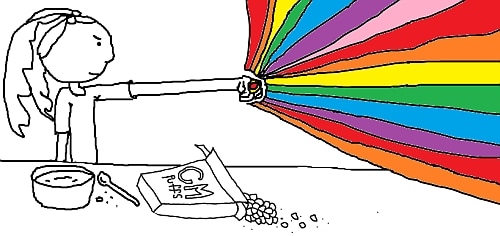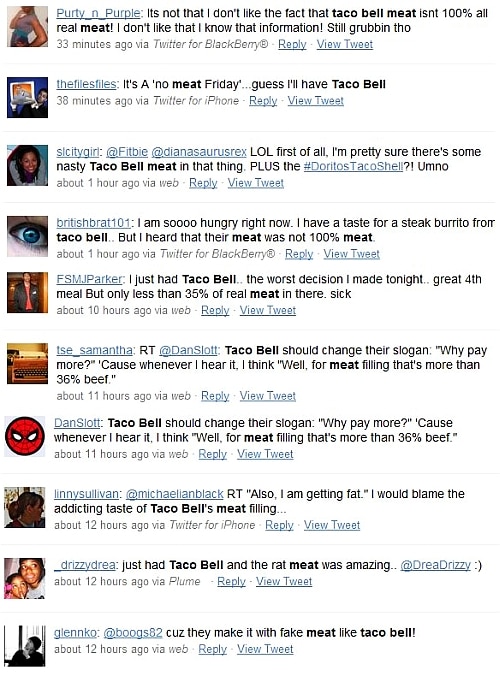Welcome, fellow community managers, to the first installment of AIMCLEAR‘s tips for lowering blood pressure, keeping cool, and effectively engaging irate customers in cyberspace, also know as part one of The Community Manager’s Guide To Intra-Community Bloodshed.
We unveiled this series last week with a sympathetic yet motivating  20,000 foot glimpse at the utter crud conflicts some of us as community managers have to deal with… trolls, haters, spammers; negative reviews on products and service; comment threads rife with false accusations; spiteful backlash from sharing benign stories; community member pitted against community member pitted against brand for reasons not even Dr. Phil could comprehend. Crises galore. But hold on a tick… are these in fact crises?
The short answer is: No. Not really. While the examples before the jump were somewhat vague, their unifying theme and cause was most likely anger (or baseless stupidity), sparked by disappointment in a brand experience. The cause was not chaos. Negative reviews left on a brand’s Facebook Page, tweets from @SocialSally blasting Company X for botching a shipping order, Joe & Jim arguing in a comment thread for all the world wide web to see—these things suck and must be addressed, but they are not social media crises. So then… what is?
What Is A Social Media Crisis?
Earlier this year, Brass Tack thinking posted a tight post that explored 3 Identifying Elements of a Social Media Crisis. By dissecting the literal definition of a “crisis” according to our friends at Merriam-Webster, co-authors Amber Naslund & Jay Baer boiled down the true indicators of an “OMG Call The Authorities!” social media moment. To surmise, social media-fueled crises are unstable, involve decisive change, and yield a highly undesirable outcome. In other words…
Social media-fueled crises can be characterized by:
- Instability & Uncertainty
- New Issues Inciting Change in Opinion of the Masses
- Potential to Affect a Large Portion of Target Audience
Let’s dig into each of these a bit deeper, along with sample scenarios. We’ll use these identifying elements to help recognize sticky social media conflicts vs. serious social media crises.
Instability & Uncertainty
As the social spokesperson for a brand, it’s the responsibility of a community manager to be informed and up-to-speed on, well, pretty much everything brand-related, at all times. Especially when sh– snot’s going down. When an issue pops up & explodes on the social media scene, you have to be prepared to react. And guess what? If you are, relax. That generally means it ain’t a crisis.
“If you know all the facts and can respond to each person coherently and assuredly,” Amber & Jay wrote, “it’s not a crisis. If you’re in the middle of the ‘fog of social media’ and you don’t really know much more than the critics, it’s definitely a crisis situation.”
Sample Scenario: Snack Food Company X unknowingly distributes a shipment of snacks that contained a tainted ingredient, and five consumers get food poisoning. The net gets wind– news stories, blog posts, YouTube video rants, angry tweets, and Facebook Wall posts amass in droves all while Snack Food Company X is just getting first reports of the events. Crisis or Conflict?
Crisis. Even if this mishap did not cause physical harm, when brand conversations about an event not yet fully understood permeate at a rate faster than the company is able manage, it’s red-level crisis. Thick in the “fog of social media,” Snack Food Company X is under the gun to get the facts, craft brand messages, address the masses, dispel inaccuracies, convey the truth, and undertake serious damage control, all in a hail of social media arrows that fly 24/7.
New Issues Inciting Change in Opinion of the Masses
It’s not always fun to dig up the past, particularly when the past is messy. Less fun is when the past is dug up for you. Thanks to the tremendous power of the Internet, doing so is fairly easy, and social media makes re-spreading the message simple, fast, and capable of viral dissemination. Resurgence of an unfortunate company incident, or reiterations of a negative perspective of a brand, can be bummers and buzz-kills. But do they suggest a crisis?
Not necessarily. Brand-bashing sucks, but if the mentality is nothing new, and mass opinion is more or less “unchanged” (one way or the other), the situation can be managable. Recommendations: thick skins and supportive PR as needed to dilute negativity. Conversely, Jay & Amber note that a “crisis is under way when a new issue emerges and the conversations around that issue spike far above the baseline level.” In other words, if more and more voices join a fresh argument or complaint against a brand, it suggests a crisis on the horizon.
Sample Scenario: Taco Bell. It’s fast food, people. It’s not gourmet. The argument surrounding this tex-mex chain’s questionable meat is nothing new. That said, it’s still alive and kicking. (The argument, not the meat…)Â Negative tweets, blog posts and Facebook statuses attack the percentage of real meat in Taco Bell’s concoctions on a daily, even hourly basis. That’s a lot of bad press. Is it a crisis, or a conflict?
Conflict. More of an obstacle than a conflict. But not a crisis. (Unless the world up and decideds to kick Taco Bell to the curb for want of better beef.) Taco Bell is one of a few household names in the fast food biz. It’s only natural that brand conversations, whether positive, negative or indifferent, pour in with moderate frequency. So long as that frequency remains at baseline, it’s manageable, predictable, and not lethal.
Potential to Affect a Large Portion of Target Audience
“Someone not getting the scone they paid for in drive-thru isn’t a crisis,” Jay & Amber wrote. Perhaps a “personal crisis” for the melodramatic scone-scarfer, but if that customer rants about a poor brand experience on Facebook, it’s not a crisis for the community manager on the other end. The magnitude of those affected by a given event is a dependable metric by which to distinguish a crisis from a conflict. Is the majority, or an increasingly large portion of your online community and target audience up in arms over what’s going on? Assess this as you prepare to move forward.
Bear in mind that intra-community uprisings aren’t always caused by a bunch of people feeling wronged. One person with one uniquely terrible brand experience can garner a sympathetic mob. On that note, more useful questions to ask include:Â “Does this single story have the potential to go viral? Could the virility cause lasting brand damage?” If the answers are yes, a crisis could unfold.
Sample Scenario: Hotel Chain Z has over a 50 hotels along the East coast. A customer had a poor experience with one hotel in particular, and ranted incessantly on Twitter. The customer happens to have decent sway in social media. Despite reaching out to resolve the issue, customer continues to tweet negative sentiments about Hotel Chain Z. Crisis? Conflict?
Conflict, with potential. Depending on how bad the experience was (did a deranged hotel employee try to kill him, or was his bed sorta lumpy?), a situation like this has the potential to evolve into something more serious if not dealt with swiftly and successfully. Otherwise, it’s conflict. Issues that occur on a local-scale are manageable in a way that “crises” are not.
So, brave community manager… as you march onward into cyberspace, consider these questions when the social snot hits the fan:
- Do I know more than the community?
- Am I capable of responding to the nature of the complaints?
- Is this a resurgence of old news?
- Are new, expanding groups of people upset?
- Has there been a major shift in brand opinion?
- Is this happening on a local or global scale?
- Does the conflict have the potential to go viral?
Some Final Words of Advice…
Relax! Keep cool. Most of the time, what you’ll be dealing with won’t be a true social media “crisis.” Quickly assess whether it is or not. If not, toss that creepy term out the window. It will only cause added stress and anxiety as you try to do your job, which is to mediate, curate, participate and monitor any and all conversations surrounding your brand. In good times, and bad.
—
Bonus Scenarios of Encouragement: Misfiring Tweets from Brand Accounts
@RedCross. @ChryslerAutos. Both brands victim to salty tweets accidentally fired under brand accounts. Crises? Conflicts? I’m leaning towards the latter. Horribly humiliating, of course. Possibility of brand damage. But no one died. The world didn’t implode. And as we’ve seen, one brand’s PR nightmare is another brand’s clever marketing bonanza.
Takeaways? Be calm but swift. If you misfire a tweet (my worst nightmare, one that’s come true once… or twice…), delete it, then promptly create and deliver a response to the situation. The Red Cross crafted a memorable tweet that balanced apology with humor, yielding tons of positive publicity, not to mention donations. We can’t all expect such an amazing outcome for our own social media slip-ups, but if this examples shows nothing else, it’s that a cool Dogfish head can go a long way.
See you next week for AIMCLEAR‘s next installment of The Community Manager’s Guide To Intra-Community Bloodshed, when we tackle Establishing Code of Conduct & Crisis Protocol.










